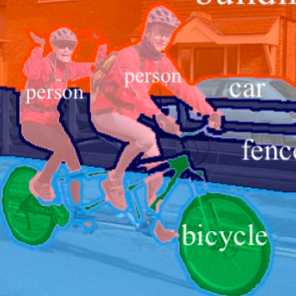Audio-visual segmentation (AVS) is a complex task that involves accurately segmenting the corresponding sounding object based on audio-visual queries. Successful audio-visual learning requires two essential components: 1) an unbiased dataset with high-quality pixel-level multi-class labels, and 2) a model capable of effectively linking audio information with its corresponding visual object. However, these two requirements are only partially addressed by current methods, with training sets containing biased audio-visual data, and models that generalise poorly beyond this biased training set. In this work, we propose a new strategy to build cost-effective and relatively unbiased audio-visual semantic segmentation benchmarks. Our strategy, called Visual Post-production (VPO), explores the observation that it is not necessary to have explicit audio-visual pairs extracted from single video sources to build such benchmarks. We also refine the previously proposed AVSBench to transform it into the audio-visual semantic segmentation benchmark AVSBench-Single+. Furthermore, this paper introduces a new pixel-wise audio-visual contrastive learning method to enable a better generalisation of the model beyond the training set. We verify the validity of the VPO strategy by showing that state-of-the-art (SOTA) models trained with datasets built by matching audio and visual data from different sources or with datasets containing audio and visual data from the same video source produce almost the same accuracy. Then, using the proposed VPO benchmarks and AVSBench-Single+, we show that our method produces more accurate audio-visual semantic segmentation than SOTA models. Code and dataset will be available.
翻译:音视频分割是一项复杂的任务,其涉及根据音视频查询准确地对应声音对象的分割。成功的音视频学习需要两个必要的组成部分:1)具有高质量像素级多类标签的无偏数据集,以及2)能够有效地将音频信息与其相应的视觉对象链接的模型。然而,目前的方法只部分解决了这两个要求,训练集包含有偏向音视频数据,并且模型在这个有偏训练集之外很难产生好的泛化能力。在这项工作中,我们提出了一种新策略来构建经济实惠且相对无偏的音视频语义分割基准。我们的策略称为“视觉后期制作”(VPO),探索了从单个视频源提取显式音视频配对不是建立这种基准所必需的观察。我们还对先前提出的AVSBench进行了改进,将其转换为音视频语义分割基准AVSBench-Single+。此外,本文提出了一种新的像素级音频视频对比学习方法,以实现模型在训练集之外的更好泛化能力。我们通过展示使用来自不同来源的音频和视觉数据进行匹配的数据集或包含来自同一视频源的音频和视觉数据的数据集进行训练的最先进(SOTA)模型产生几乎相同的准确性来验证VPO策略的有效性。然后,使用所提出的VPO基准和AVSBench-Single+,我们展示了我们的方法产生了比SOTA模型更为准确的音视频语义分割。代码和数据集将可用。


